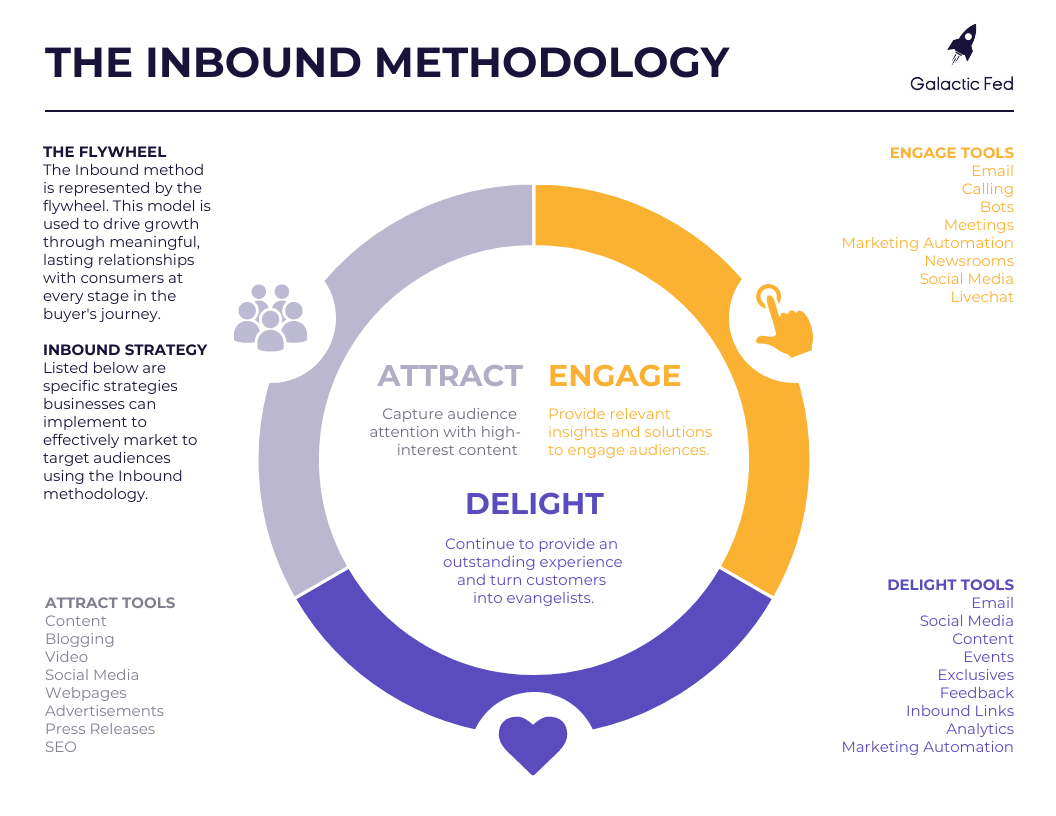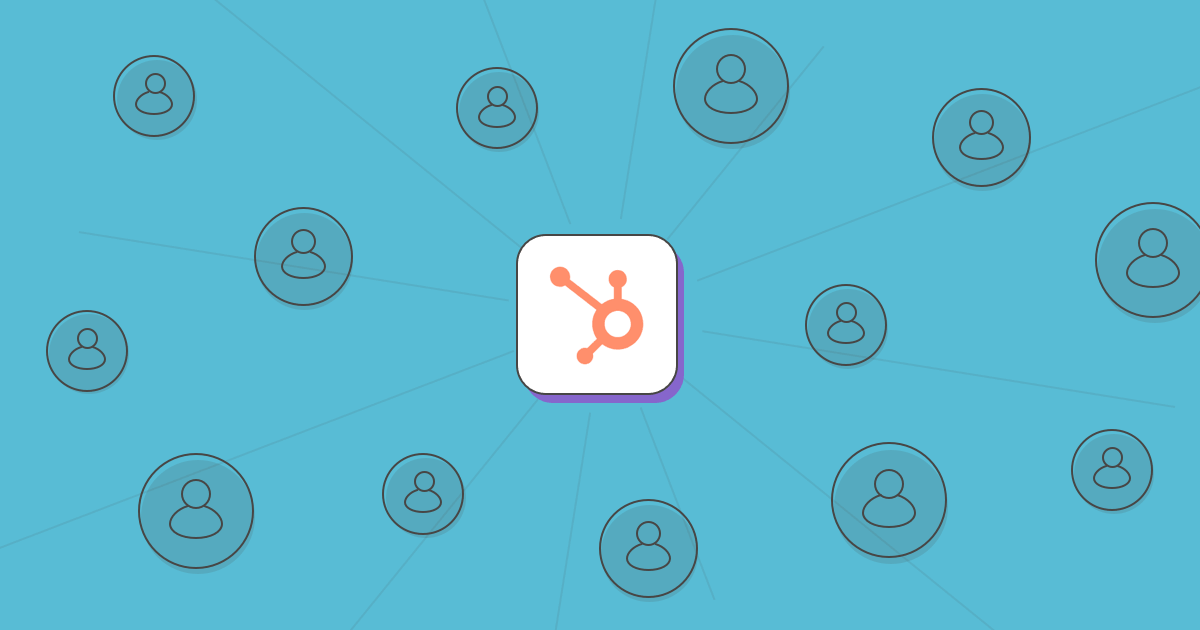This article was written by Brandon Sanders, former Acquisition Marketing Manager at HubSpot.
“There is only one boss. The customer. And he can fire everybody in the company from the chairman on down, simply by spending his money somewhere else.”
– Sam Walton, Founder of Walmart and Sam’s Club
Think about Walton’s quote for a minute.
Whether your business is a startup or in growth or scale mode, attracting, engaging, and delighting your ideal audience is key to not only surviving, but thriving. Why? 80% of future profits come from 20% of current customers.
The inbound methodology and customer engagement
The inbound methodology is the method of growing your organization by building meaningful, lasting relationships with consumers, prospects, and customers. It’s about valuing and empowering these people to reach their goals at any stage in their journey with you.
Below is a graphic that explains the inbound approach to business that revolves around serving your customers.

Relationships are not developed overnight. It can take time to establish a meaningful connection with your audience. This is where customer engagement comes in as a key ingredient in the recipe on how to develop a loyal following that advocates for your business.
In this article, we’re going to answer the following questions:
- What is customer engagement?
- Why should you care about customer engagement?
- How do you track customer engagement?
- What customer engagement metrics should I care about?
What is customer engagement?
Customer engagement involves actively interacting with your audience with content that interests, educates, motivates, and/or transforms them. This is achieved through two-way communication, not just your business broadcasting content.
What’s the difference between active and passive engagement?
Passive engagement is when someone visits one of your channels but doesn’t take action. For example, a visitor finds a blog post on your website, reads it, then leaves without clicking anything on the page.
Active engagement is when someone visits one of your channels and performs a specific action. For example, a visitor finds a blog post on your website, reads it, sees a call-to-action for a content offer at the end of the page, clicks it, and fills out a form to access it.
Why should you care about customer engagement?
Once you acquire a customer, you should do everything you can to keep them. Not only will they likely purchase from your business if they have a good experience in the future, but also, and more importantly, it’s 5x more expensive to acquire a new customer than to keep a current customer.
The goal with customer engagement is to build a meaningful relationship based on a foundation of trust. In order to build trust, you need to have a good understanding of your customer and their journey to making a well-informed decision.
What is the customer journey?
The customer journey is the complete sum of experiences that customers go through when interacting with your company and brand. Instead of looking at only part of a transaction or experience (like reading a blog post and filling out a form to receive a content offer), the customer journey documents the full experience of being a customer.
Something important to note is your audience likely won’t know their customer journey. It’s up to you to figure this experience out and offer it to them. Whichever business takes the time to do so will likely win.
Here are two things you can do to ensure your messaging and focus are aligned.
- Develop buyer persona(s)—a semi-fictional representation of your ideal audience.
- Identify a clear customer journey that comprises a series of engagements. It’s likely there are trends in your customers’ engagement habits. Keeping this in mind, think of each customer engagement (passive or active) as an ingredient to concocting a scalable customer journey.
How do you track customer engagement?
Once you identify your business’ buyer persona(s) and establish their customer journey, you need to put data-driven technology in place that tracks their journey. This includes:
- Website analytics and dashboard software
- Customer relationship management software (CRM)
Let’s review both in more detail.
Website analytics and dashboards software
Website analytics software is designed to track, measure, and report on website activity. This activity generally is featured via a dashboard where the data is split into specific categories, like:
- Audience data (i.e., number of visits, new vs. returning visitor ratio, etc.)
- Audience behavior (i.e., number of pages per visit, common landing and exit pages, etc.)
- Campaign data (i.e., referral traffic, most effective distribution channels, etc.)
Businesses use website analytics to better understand a macro-level view of user behavior across website pages.
Looking for a free marketing analytics and dashboard software to try? Check out Google Analytics.
Customer relationship management software (CRM)
A CRM is a tool that you can use to manage relationships with your customers. It helps keep track of contacts within a business. This includes communication with your business (i.e., emails, conversations, etc.) as well as active and passive engagements taken on your website. Having this information stored in a centralized location has its benefits:
- Increases communication between the sales and marketing team
- Sends the right type of communication to your contacts at the right time of the customer journey
Businesses use a CRM to track micro-level activities and engagements of a specific contact.
Looking for a free CRM to try? Check out HubSpot’s CRM.
What customer engagement metrics should I care about?
Not all metrics are created equal. In order to get a high-level view of how your audience is interacting with your brand, make it a best practice to track these customer engagement metrics:
- Visit frequency
- Pages per session
- Conversion rate (CVR)
- Net Promoter Score (NPS)
- Customer lifetime value (CLTV)
Below is a brief overview of each metric to help you get started.
Visit frequency
Visit frequency measures how often someone comes back to your website.
Someone who visits your site often is likely finding value in what you have to offer. This is why it’s important to publish new content on a consistent basis to give people a reason to come back.
As you dig into the data, start to look for patterns in engagement. As you start to identify trends, you can use this information to make adjustments in communication and promotion.
Pages per session
Pages per session metric measures how many pages of your website a user clicks through to within a single visit (also known as a “session”).
A high page-per-session rate is a good indicator that people find value in your content. A low page-per-session rate could indicate that your content is either too broad or irrelevant.
Conversion rate (CVR)
CVR measures the percentage of people who complete a specific action. Here’s a standard formula for calculating conversion rate:
Total number of conversions (i.e., forms completed, sign-ups, downloads, etc.) divided by total number of visitors
For example, let’s assume 400 people visited a landing page for one of your content offers last month, and 20 people converted on it (i.e., fill out a form to receive it). Your conversion rate would be 20 / 400 = .05, or 5%.
A high conversion rate is a good indicator that you’re producing valuable content and promoting it effectively.
Net Promoter Score (NPS)
NPS measures customer loyalty. It measures how likely someone would be willing to promote the experience you’re offering.
You can calculate NPS by:
- Surveying someone on a scale from 0-10 how likely they would be to recommend something to a friend. This could be a specific piece of content, an experience your brand has offered, and so on.
- Once you have multiple NPS responses, you can calculate the NPS score with this free online calculator.

Looking for a free feedback survey platform? Check out Delighted’s NPS tool.
Customer lifetime value (CLTV)
CLTV value measures the amount of revenue a business can expect from a customer over the entire relationship. This user engagement metric is straightforward. All you have to do is understand your customer experience flow and measure feedback across all key touchpoints.
CLTV value measures the amount of revenue a business can expect from a customer over the entire relationship. This user engagement metric is straightforward. All you have to do is understand your customer experience flow and measure feedback across all key touchpoints.
LTV = Average purchase value × Number of transactions × Retention time period
Once you know LTV…
LTV x Profit margin = CLTV
Your company should look for ways to improve and optimize for CLTV. Why? Because 80% of future profits come from 20% of current customers.
Pro tip: Consider the customer journey you’re striving to create and determine the various customer engagement metrics you need to track, measure, and optimize over time to get there.
Measuring and improving customer engagement can require many platforms and teams to work together. If you’re just getting started, platforms like HubSpot and Delighted also come with pre-built integrations so that you can have all of your feedback and CRM data in one place.
About Brandon Sanders
Brandon Sanders is a former Acquisition Marketing Manager for HubSpot. He loves to learn and teach others. Having obtained a degree in Digital Technology and Culture, with years of experience working in B2B SaaS, Brandon is highly skilled in digital marketing. Brandon has been featured in HubSpot Academy’s digital advertising certification course, which helps thousands of professionals across the globe learn and grow.







